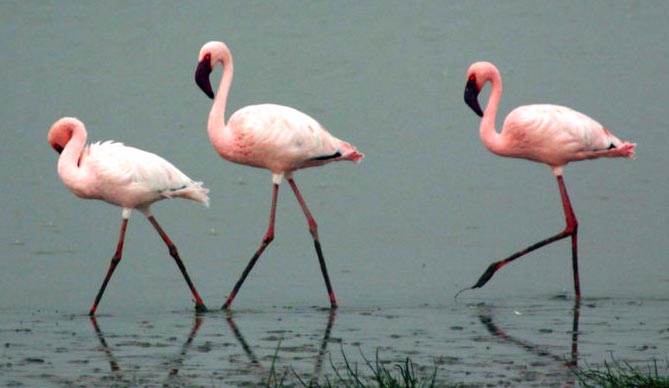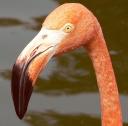
Travel India Flamingoes of Mumbai
When I was about 9 or 10 years old (well, 
that was a good five and a half decades ago),
I first read about the Flamingo in Lewis Carroll’s
wonderful book – Alice in Wonderland.
So strange was the depiction that I thought the Flamingo was an imaginary bird.
Flamingoes are truly strange looking birds.
And they feed in a peculiar fashion.
They immerse their entire heads in the mud in the bottom of the water – upside down.
Description
There are six species of flamingoes in the world.
Of these, only two species – the Greater Flamingo (Phoenicopterus roseus) and the Lesser Flamingo (Phoeniconaias minor) are found in India.
The spread of these two species are as follows:
1. Greater Flamingo (P. roseus) (most widespread flamingo) –
are found in parts of Africa, S. Europe and S. and S.W. Asia.
2. Lesser Flamingo (P. minor) (most numerous flamingo) –
are found from Africa (e.g. Great Rift Valley) to N.W. India.
The Lesser Flamingo is slightly shorter and lighter.
When landing, the procedure is reversed.
The bird touches down and then runs several paces.
The flight speed of a flock of flamingoes can reach 50 to 60 kph (31-37 mph).
But the reason for this behavior is not fully known.
Flamingoes of Mumbai

Flamingoes are non migratory birds. But they do move about between different habitats.
During the winter months, flocks of flamingoes come from the colder parts of India to various coastal areas of India – especially to areas where there are plenty of salt pans.
They even come to the mudflats off Sewri (near Central Mumbai) and some parts of Thane every year to nest, lay eggs, hatch their chicks, help them grow and then they fly away.
There are numerous mudflats and mangroves in the creeks across Sewri.
These accumulate organic minerals, which in turn harbour planktons, crustaceans and shrimps.
These attract a lot of different species of birds, including flamingoes.
Both the Greater and the Lesser Flamingoes can be seen here from middle of October to late May.
The Lesser ones are more abundant than the Greater ones with their numbers crossing fifteen thousand.
Flamingoes’ nests
The nest is just a mound of mud, about 12 inches (30 centimeters) high to protect the egg from flooding during high tide and from the occasional intense heat at ground level.
Both the male and female help build the nest by drawing mud toward their feet with their beaks.

The female Flamingo lays a single large egg, which is incubated by both parents.
At hatching, a Flamingo chick has gray down feathers.
It also has a straight, pink bill and swollen pink legs, both of which turn black within a week.
For about two months, the chick feeds on milk produced by both and female Flamingoes.
This is not true milk produced by the mamillary glands – but ‘crop milk’ a secretion from the parents’ upper digestive tract due to the action of a hormone called prolactin.
Even pigeons produce this kind of milk.

Their oddly-shaped beaks are specially adapted to separate mud and silt from the food they eat, and are uniquely used upside-down.
The filtering of food items is assisted by hairy structures called lamellae which line the mandibles, and the large rough-surfaced tongue.
The flamingoe’s characteristic pink colouring is caused by the Beta carotene which comes from shrimp and blue-green algae in their diet.
A well-fed, healthy flamingo having its full quota of Beta carotene is more vibrantly coloured.
Flamingoes at Mithi Mahim creek in Mumbai
In the last week of June 2008, for the first time ever, bird watchers saw a flock of 11 Flamingoes at the Mithi river – where it meets the Mahim creek.
This is the time when the Flamingoes leave for their home.
It is even possible that for some reason, the birds, mostly young, could not fly back with their parents.
Time alone will tell us whether they are here to stay and whether the site will attract other Flamingoes in future.
But the phenomenon does indicate that the Mithi (which means sweet – and this is what the river water once was) has become sweeter (cleaner).

Excellent site. It was pleasant to me.
Excellent site. It was pleasant to me.
viagra
I want to say – thank you for this!
cialis
Excellent site. It was pleasant to me.